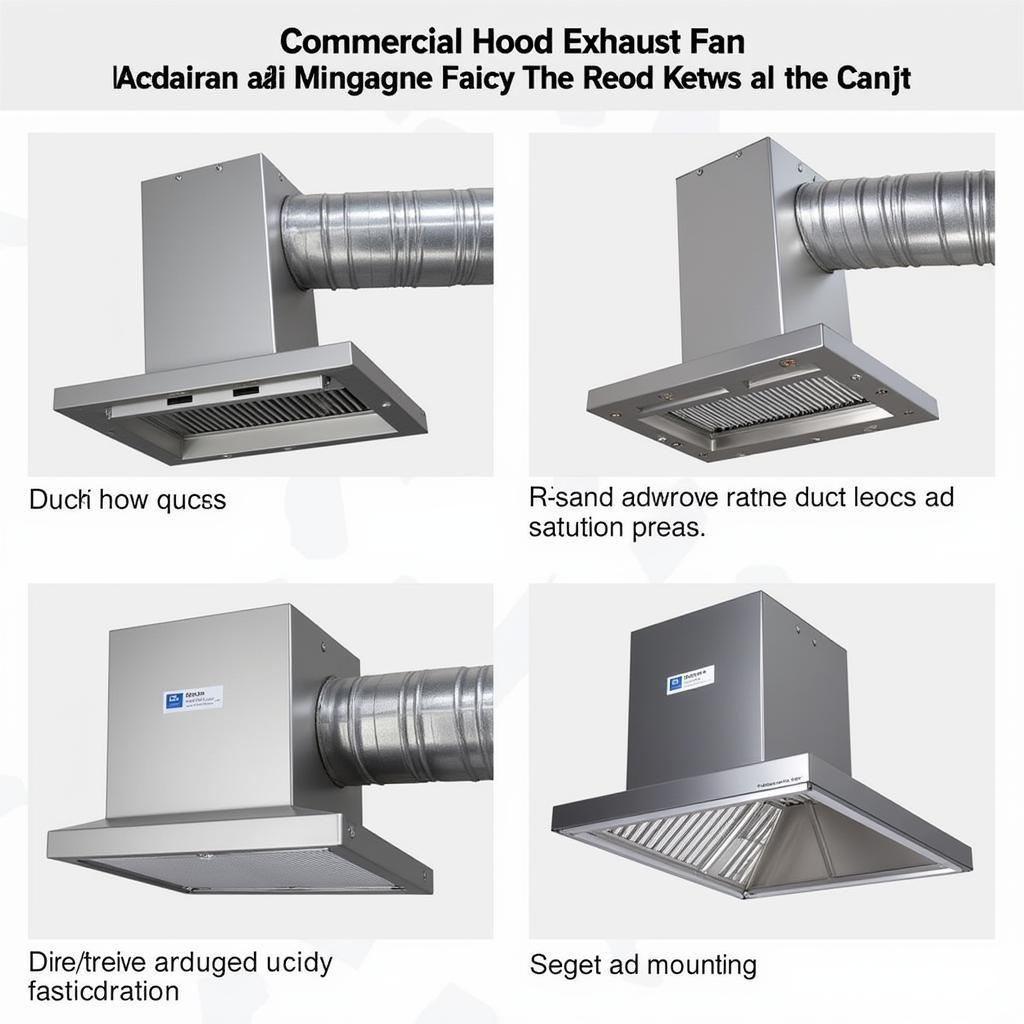Commercial Range Hood Exhaust Fans are essential for maintaining a safe and comfortable kitchen environment. They remove grease, smoke, and odors, ensuring proper ventilation and preventing the buildup of harmful pollutants. Selecting the right exhaust fan is crucial for optimal performance and meeting health and safety regulations. This guide will delve into the key factors to consider when choosing a commercial range hood exhaust fan for your business.
Choosing the right exhaust fan can be a daunting task given the variety of models and specifications available. This involves understanding your kitchen’s specific needs, considering factors such as airflow, noise levels, and maintenance requirements. From understanding the basics of CFM to exploring different types of fans, this guide provides a comprehensive overview. Let’s get started!
Understanding Commercial Exhaust Fan Needs
Before diving into the specifics, it’s essential to evaluate your kitchen’s ventilation needs. Factors like cooking style, frequency of use, and kitchen size all play a role in determining the right exhaust fan. A small cafe with light cooking will have different requirements than a bustling restaurant with multiple fryers and grills. Consider also the type of food being prepared; greasy foods require more powerful ventilation.
A good starting point is to consult local building codes and regulations. These often dictate minimum ventilation requirements for commercial kitchens. You can also check resources like the National Fire Protection Association (NFPA) for guidelines on kitchen ventilation systems. Accurately assessing your needs will ensure you choose a fan that effectively removes airborne contaminants and creates a healthy working environment. Check our guide on kitchen hood exhaust fan for more information about kitchen hoods.
Key Considerations for Choosing a Commercial Range Hood Exhaust Fan
Selecting the correct commercial range hood exhaust fan involves understanding several key factors. Making informed decisions about these elements will ensure your chosen fan effectively ventilates your kitchen.
Airflow (CFM)
CFM (cubic feet per minute) is a critical metric, indicating the volume of air the fan can move per minute. Higher CFM ratings mean more powerful extraction. Calculate the required CFM based on your kitchen size and cooking equipment. For example, a larger kitchen with heavy cooking equipment will need a higher CFM than a smaller kitchen with less demanding appliances.
Noise Levels (Sones)
While airflow is vital, noise levels are also a significant consideration. Excessive fan noise can create a disruptive environment for both staff and customers. Look for fans with lower sone ratings for quieter operation, promoting a more comfortable atmosphere in your kitchen and dining area.
Grease Filtration
Effective grease filtration is crucial for fire prevention and maintaining hygiene. High-quality filters capture grease particles, preventing them from accumulating in the ductwork and reducing the risk of fire hazards. Regularly cleaning or replacing filters is essential for optimal performance and safety.
Fan Type
Different fan types are available, each with its pros and cons. Upblast fans are common in commercial settings, discharging air vertically through the roof. Inline fans, often used for longer duct runs, can be installed within the ductwork itself. Consider factors like space constraints and ductwork configuration when selecting a fan type. For more insights into inline fans, you can refer to our guide on inline cabinet fan type.
Maintenance and Cleaning
Regular maintenance is essential for the longevity and efficiency of your exhaust fan. Choose a fan with easily accessible components for cleaning and filter replacement. Scheduled maintenance will minimize downtime and prevent costly repairs down the line. You might find our guide on ceiling fan repair near me helpful for general fan maintenance tips.
Ductwork Considerations
Proper ductwork design and installation are essential for efficient ventilation. Ensure the ductwork is appropriately sized and sealed to minimize air leakage and maximize airflow. Consult with a professional to ensure your ductwork meets code requirements and optimizes fan performance.
Expert Insights
“Choosing the right exhaust fan isn’t just about airflow,” says John Smith, a certified HVAC technician with 20 years of experience. “It’s about balancing performance, noise levels, and maintenance to create a healthy and efficient kitchen environment.” He emphasizes the importance of regular filter cleaning and professional inspections to ensure long-term performance.
 Commercial Kitchen Exhaust Fan Installation Process
Commercial Kitchen Exhaust Fan Installation Process
“Investing in a high-quality, properly installed exhaust fan is a crucial investment for any food service business,” adds Maria Garcia, a restaurant consultant with over 15 years of industry experience. “It not only protects your staff and customers but also contributes to the overall efficiency and longevity of your kitchen equipment.”
Conclusion
Choosing the right commercial range hood exhaust fan is a crucial decision that impacts the safety, hygiene, and efficiency of your kitchen. By considering factors like airflow, noise levels, grease filtration, and maintenance requirements, you can select a fan that meets your specific needs and ensures a healthy and productive work environment. Remember to consult with professionals and adhere to local regulations for optimal results. For more information about automatic exhaust fans, see our guide on automatic exhaust fan.
FAQs
- What is the ideal CFM for my commercial kitchen? This depends on your kitchen size and cooking equipment. Consult with a professional for an accurate assessment.
- How often should I clean my exhaust fan filters? Regular cleaning, typically every few weeks, is recommended. Replace filters as needed.
- What are the different types of commercial exhaust fans? Common types include upblast fans, inline fans, and wall-mounted fans.
- Do I need professional installation for my exhaust fan? Professional installation is highly recommended for proper and safe operation.
- How can I reduce noise levels from my exhaust fan? Choose a fan with a lower sone rating and ensure proper ductwork installation.
- What are the fire safety regulations regarding commercial exhaust fans? Consult local codes and the NFPA for specific guidelines.
- How can I improve the efficiency of my exhaust system? Regular maintenance, proper ductwork, and choosing the right fan are key factors.
Scenarios:
- Scenario 1: A bustling restaurant with multiple fryers and grills requires a high-CFM upblast fan with efficient grease filtration.
- Scenario 2: A small cafe with light cooking may opt for a lower-CFM wall-mounted fan with quieter operation.
- Scenario 3: A food truck with limited space might benefit from a compact inline fan installed within the ductwork.
Further Reading
Explore related articles on our website, such as “Understanding Kitchen Ventilation Systems” and “Choosing the Right Exhaust Fan for Your Business.” You can also find information on exhaust fans tłuamczenie for translations.
Need help with choosing the perfect commercial range hood exhaust fan? Contact us! Phone: 0903426737, Email: [email protected]. Or visit us at: Lot 9, Zone 6, Gieng Day Ward, Ha Long City, Quang Ninh, Vietnam. Our customer service team is available 24/7.





